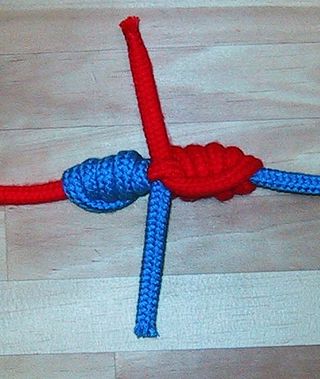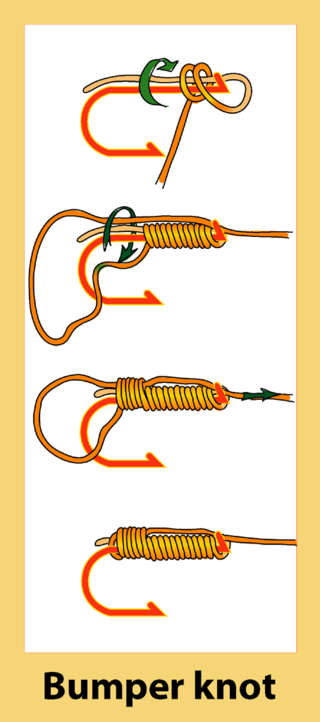
Trolling is a method of fishing where one or more fishing lines, baited with lures or bait fish, are drawn through the water at a consistent, low speed. This may be behind a moving boat, or by slowly winding the line in when fishing from a static position, or even sweeping the line from side-to-side, e.g. when fishing from a jetty. Trolling is used to catch pelagic fish such as salmon, mackerel and kingfish.

A fishing line is any flexible, high-tensile cord used in angling to tether and pull in fish, in conjunction with at least one hook. Fishing lines are usually pulled by and stored in a reel, but can also be retrieved by hand, with a fixed attachment to the end of a rod, or via a motorized trolling outrigger.

A blood knot is a bend knot most usefully employed for joining sections of monofilament nylon line while maintaining a high portion of the line's inherent strength. Other knots used for this purpose can cause a substantial loss of strength. In fly fishing, this serves to build a leader of gradually decreasing diameter with the castable fly line attached at the large diameter end and the fly or hook at the small diameter end. The principal drawback to the blood knot is the dexterity required to tie it. It is also likely to jam, which is not a concern in fishing line, which is no great loss to cut, but may be a concern in normal rope. "Blood knot" may refer to "a double overhand knot tied in a cat-o'-nine-tails."
The barrel knot, called blood knot by Keith Rollo, is the best bend there is for small, stiff or slippery line. The ends may be trimmed short and the knot offers the least resistance possible when drawn through water.

The Cat's paw is a knot used for connecting a rope to an object. It is very similar to the cow hitch except there is an additional twist on each side of the bight, making it less prone to slipping.
The cat's-paw is the common hook hitch for slings. It is the same basic form as the bale sling hitch but has additional twists. Brady says "two or three altogether," and Steel, who mentioned the name in 1794, says "three twists." It is the best of all sling hitches and is often recommended for a slippery rope. But no hitch can slip when tied in a slings since it has no ends. All that is needed is a hitch that cannot jam, and this requirement the cat's-paw fills admirably. The knot spills instantly when removed from the hook. It is the hitch always used for heavy lifts.

A fishing lure is any one of a broad category of artificial angling baits that are inedible replicas designed to mimic prey animals that attract the attention of predatory fish, typically via appearances, flashy colors, bright reflections, movements, vibrations and/or loud noises which appeal to the fish's predation instinct and entice it into gulping the lure. Angling activities using lures are known as lure fishing.

In fishing, a bumper knot can be used to secure soft or loose bait, including clusters of eggs, to a hook.

A fish hook or fishhook, formerly also called an angle, is a hook used to catch fish either by piercing and embedding onto the inside of the fish mouth (angling) or, more rarely, by impaling and snagging the external fish body. Fish hooks are normally attached to a line, which tethers the target fish to the angler for retrieval, and are typically dressed with some form of bait or lure that entices the fish to swallow the hook out of its own natural instinct to forage or hunt.

The Arbor knot is a typical fishers' knot. Its primary use is to attach fishing line to the arbor of a fishing reel.

The Bimini twist is a fishing knot used for offshore trolling and sportsfishing and the creation of double-line leaders.

The nail knot, also known as the tube knot or gryp knot, is mostly used in carp and fly-fishing. The nail knot was named because a nail was inserted as a guide when threading the line. Today, it is easier to use a small straw. The nail knot is an important fishing knot used to join two lines of different diameters and allows for line diameters to diminish down to the fly. I.E., it is useful for attaching your backing to the fly line, and your fly line to the leader, or tippet. The knot can be tied in multiple ways and is uniform.

The Palomar knot is a knot that is used for securing a fishing line to a fishing lure, snap or swivel.

Fishing tackle is the equipment used by anglers when fishing. Almost any equipment or gear used in fishing can be called fishing tackle, examples being hooks, lines, baits/lures, rods, reels, floats, sinkers/feeders, nets, spears, gaffs and traps, as well as wires, snaps, beads, spoons, blades, spinners, clevises and tools that make it easy to tie knots.

A turle knot is a knot used while fishing for tying a hook or fly to a leader. It is named after Major William Greer Turle, a 19th-century English angler who popularized the knot but did not claim to have invented it. Turle was a contemporary of Frederic M. Halford and fished the chalkstreams of Hampshire with Halford in the late 19th century and was an early pioneer in the use of eyed hooks for fly fishing. It has sometimes, wrongly, been referred to as the turtle knot.
Drop shotting is a highly finesse angling technique using plastic baits, consisting of a small thin-wire hook with a weight (sinker) attached to the tag end of the line. This is in contrast to the more traditional Texas Rig, where the weight slides inline, resting on the nose of the bait; or the Carolina Rig, where the weight is fixed above the bait. The dropshot rig provides the ability to keep a hook and lure off the bottom with a more "weightless"-looking posture. Usually the bait is fished by letting the weight hit the bottom and then twitch the rod tip, causing the lure to shake in a jumping-like action, but can also be flipped, dragged, hopped or jigged along the bottom. This simple but versatile technique has endless combinations with the different hooks, soft plastics and weights that can be used.[1] The aim is to present a free floating, slow twitching lure to induce a strike from non-aggressive fish. This rig is commonly used in bass fishing for catching smallmouth, largemouth and spotted bass, but can be used for a variety of other bottom-dwelling fish species, as well.

The uni knot is a multi-purpose fishing knot used in angling that can be used for attaching the fishing line to the spool of a reel, for joining main line to leader/backing lines, and for attaching lures, swivels and snaps.

The Trilene knot is a multi purpose fishing knot that can be used for attaching monofilament line to hooks, swivels and lures. It resists slippage and failures. The knot was apparently in use at least as early as 1975 when it was included in Tom McNally's Complete Book of Fishermen's Knots as the "double-looped clinch knot". However, professional anglers Jimmy Houston and Ricky Green would later claim that they invented the knot in the late 1970s while experimenting during promotional events for Trilene, a fishing line manufacturer. Both men favored the idea of naming the knot after themselves, though Trilene ultimately applied its own name instead. It's unclear whether Houston, Green or Trilene were aware of the knot's earlier invention or its prior inclusion in McNally's book.

The knotless knot is a hitch knot used to attach an eyed fishing hook to fishing line while leaving a length of line hanging below the hook. The extra length of line can then be used as the hair of a hair rig.
The San Diego jam knot is a common fishing knot used to tie a line to the hook, swivel, clip, or artificial fly. This knot is also known as the San Diego knot, reverse clinch knot or Heiliger knot.
















